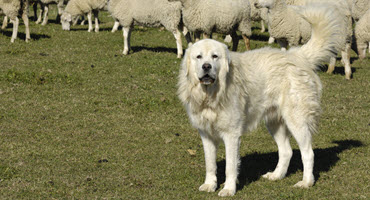
The Great Pyrenees (also known as the Pyrenean Mountain Dog) is a large heavily built canine traditionally used to protect sheep from predators like wolves and bears[i]. A typical adult male stands up to 31” tall and weighs as much as 165 pounds. The breed is gentle and highly affectionate but protective of its owners.
My Recent Encounter with a Great Pyrenees
I recently encountered a Great Pyrenees near the vacation home my wife and I own in the Blue Ridge Mountains of western North Carolina. It was a lovely early spring day, and I had just started painting an outdoor railing when I heard a dog whimpering at the end of our road. Looking in that direction, I saw a big white dog who seemed unhappy about being tied up. At first, I shrugged it off thinking he belonged to the occupants of the nearby house. But when the dog continued to whimper, my love of animals overcame my desire to complete the paint job I had started. I put down my brush and went to determine the reason for the dog’s distress. Seeing no cars in the driveway, I knocked on the door to make sure its occupants were aware of the situation. When no one answered, I thought Fido must have been left by someone who had to run into town for a few groceries (or something innocent like that).
As I approached the immense, thickly coated animal, I remembered a heavily publicized story of a bull terrier tied to a post and abandoned by its owner who was fleeing the rising floodwaters of Hurricane Milton[ii]. The memory of Hurricane Helene, which had claimed the lives of many people and their pets[iii] in our area last fall, was still too fresh to ignore the plight of this stranded creature.
So, I went into rescue mode.
How Not to Rescue a Mountain Dog
The dog whose collar said his name was “Chief” was not tied but rather his retractable leash had been snagged by the rocks in front of the neighboring home. Although he seemed friendly and in good shape, I was worried that he had been trapped for a long time. I ran back to my house to get a bowl of water and a few treats which Chief quickly consumed.
I then noticed a telephone number engraved on Chief’s collar tag. Snapping a quick photo on my cell phone, I texted it to the presumed owner asking, “is this your dog”? When I didn’t get an immediate response, I returned to my painting.
Sometime later, I did receive a text from someone informing me that Chief “had gotten away from him on their morning walk.” However, the man said he was now about 50 miles away and couldn’t get back to retrieve his dog for several hours. City boy that I am, I found it hard to understand why anyone would leave a beautiful pedigreed dog running loose in the mountains. Suppressing my critical spirit, I offered to return Chief to his home once I learned it was only about a mile away. The owner thanked me but seemed oddly unconcerned about his runaway dog.
No Good Deed Goes Unpunished?
That’s when things got interesting. Consistent with the age-old adage that “no good deed goes unpunished”, Chief was not about to be rescued. Not even by someone who had freed him from his bondage and offered him a few treats. Apparently he had been taught never to get in a stranger’s car, so adamantly refused the free ride. After several unsuccessful attempts to transport the big guy by car, I put my painting on hold and decided to walk Chief back home. After all, it was a beautiful day, and I hoped a kind neighbor would do the same for my dog if she ever got lost.
Once Chief realized his walkabout was over, he lowered his head and easily slipped out of his collar. In a flash, he ran up a hillside and disappeared into the deep woods. Collarless, he was now free to roam incognito – which likely was his plan all along.
How humiliating. What sort of animal rescuer was I? How would I explain my carelessness to Chief’s owner? I spent the next hour driving around desperately looking for Chief but to no avail. Chief was gone.
When I called the owner to tell him what had happened, he was surprisingly untroubled. He wanted me to know that he and his wife were vegetable farmers and inquired whether I had ever bought their produce at the town’s weekly farmers’ market. He appeared more concerned about gaining a new customer than getting his dog back. This made sense after he admitted that Chief had only been with his family for a few weeks. The dog’s original owner had moved away suddenly and asked whether Chief could stay with them until he got more settled. The farm family agreed to adopt Chief but soon discovered that he, like many country dogs, was in the habit of wandering.
All’s Well That Ends Well
The dog’s backstory should have relieved me of any guilt, but I still felt bad about having made matters worse. Later that day, remorsefully I drove to the farm to return Chief’s collar and leash. The farmer’s three sons and an untethered brown dog greeted me beside a huge greenhouse. The father soon appeared and thanked me again for trying to rescue Chief. He said he and his wife had also attempted to find the lost dog but initially concluded “he was gone for good”.
But, lo and behold, when they arrived home, Chief was there waiting for them. The boys said he had returned “on his recognizance” and they had just finished tying him to the porch. I looked up at the farmhouse, and there was the big fella with his tongue hanging out. It might have been my imagination, but he seemed to be laughing at me – that silly city boy who thought he could control a free-spirited country dog.
Since all of this happened, I’ve done a little research on Great Pyrenees. Most notably, I learned that because they were bred to herd and protect sheep, they have a tendency to roam.[iv] Some members of this breed have been known to travel up to 10 miles to protect their territory or family.[v] Secure fencing is critical, and many owners say that a fence of at least 5 feet tall is needed if the dog is seen attempting to scale a barrier that high.[vi]

Like One of Aesop’s Fables
This additional information brought to mind one of Aesop’s Fables from childhood: “The Town Mouse and the Country Mouse”. In the original tale, a proud town mouse visits his cousin in the country. The country mouse offers the town mouse a meal of simple country cuisine, at which the visitor scoffs and invites the country mouse back to the city for a taste of the finer life. But their urban feast is interrupted by a cat forcing the cousins to leave their meal and retreat into a mouse hole.[vii]
The story is said to be based upon a tale dating to Classical times. It’s so old that even Roman Emperor Marcus Aurelius referenced it in his book Meditations:
“Think of the country mouse and of the town mouse, and the alarm and trepidation of the town mouse.”[viii]
There are many things about country life I like. That’s probably why I spend so much of my free time in a very rural part of America. I’ve always found country people more authentic than city folk. They’re independent, less swayed by popular trends and, for the most part, comfortable with who they are. Now I know their dogs share many of the same qualities.
[i] https://www.akc.org/dog-breeds
[ii] Richard Polinna, “Florida dog ‘Trooper’ tied to fence during Hurricane Milton finds his forever home while cruel ex-owner awaits court date”, New York Post, December 5, 2024.
[iii] Meganne Natale, “Hurricane Helene’s Destruction: A Catastrophe for Animals”, World Animal Protection US, October 3, 2024.
[iv] Great Pyrenees Rescue Society notes that “if you are looking for a dog who will be an off-leash companion and follow your every command, the Pyrenees is not for you.”
[v] Great Pyrenees Rescue of Montana.
[vi] Great Pyrenees Club of Southern Ontario.
[vii] Wikipedia, “The Town Mouse and the Country Mouse”.
[viii] Timeless Classics, Prometheus Books, 1991 at chapter 11, verse 22.

Be First to Comment